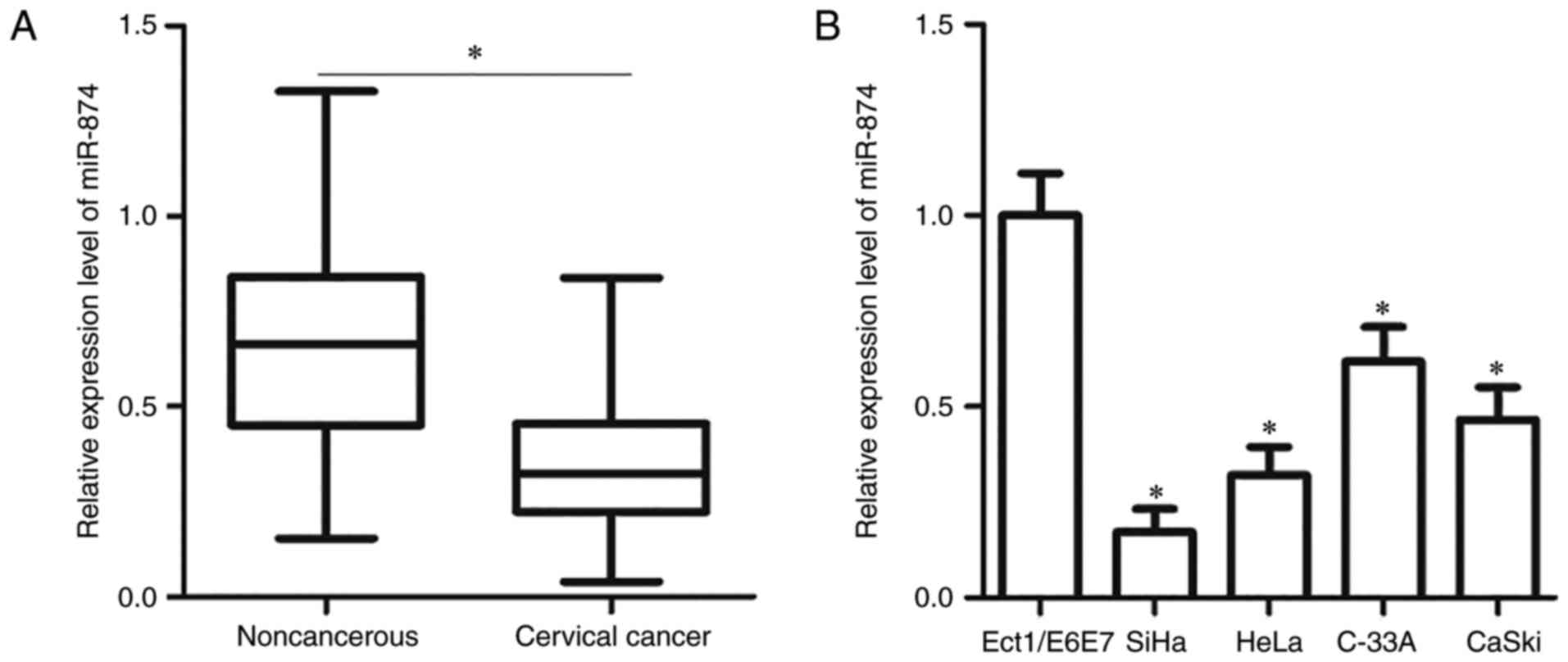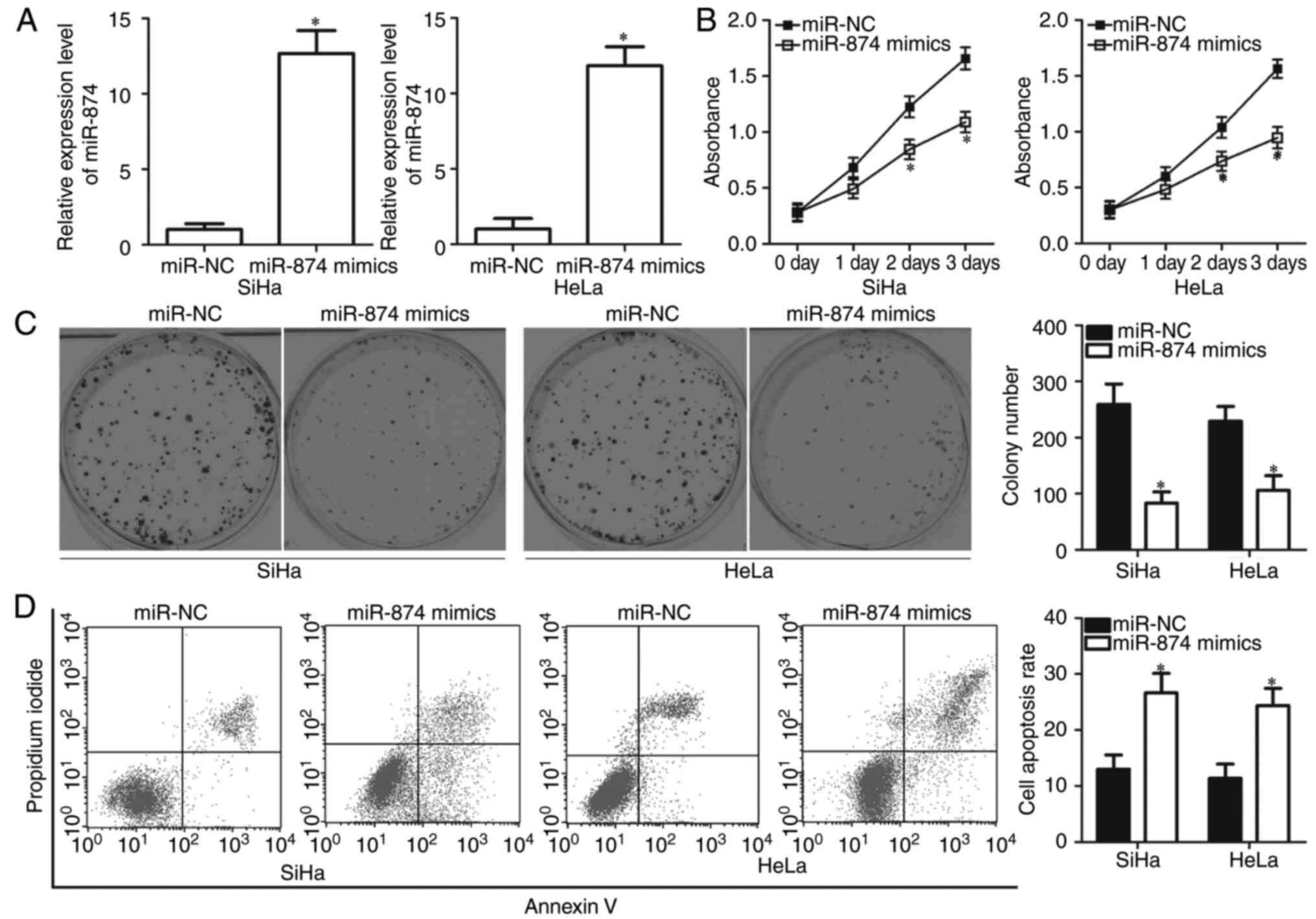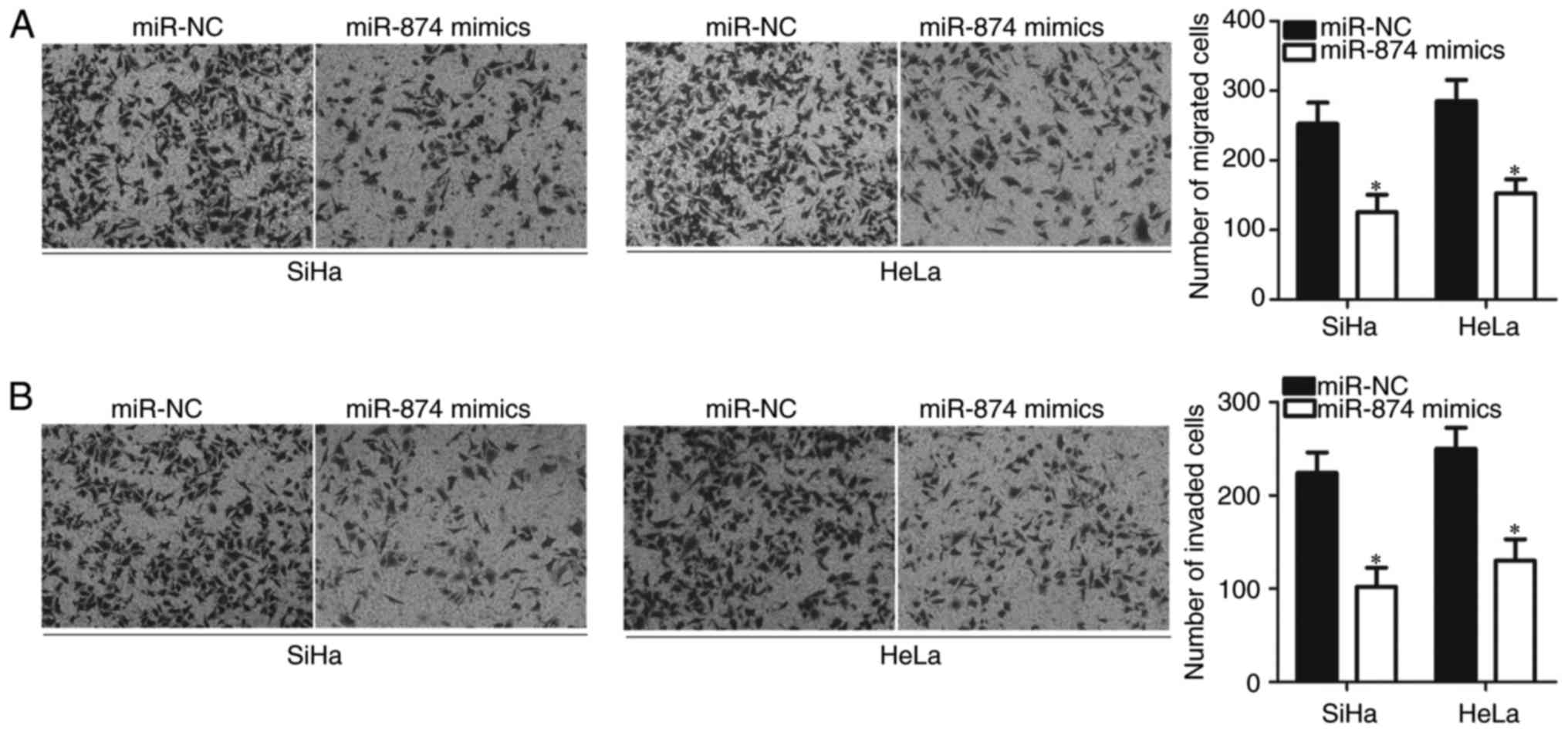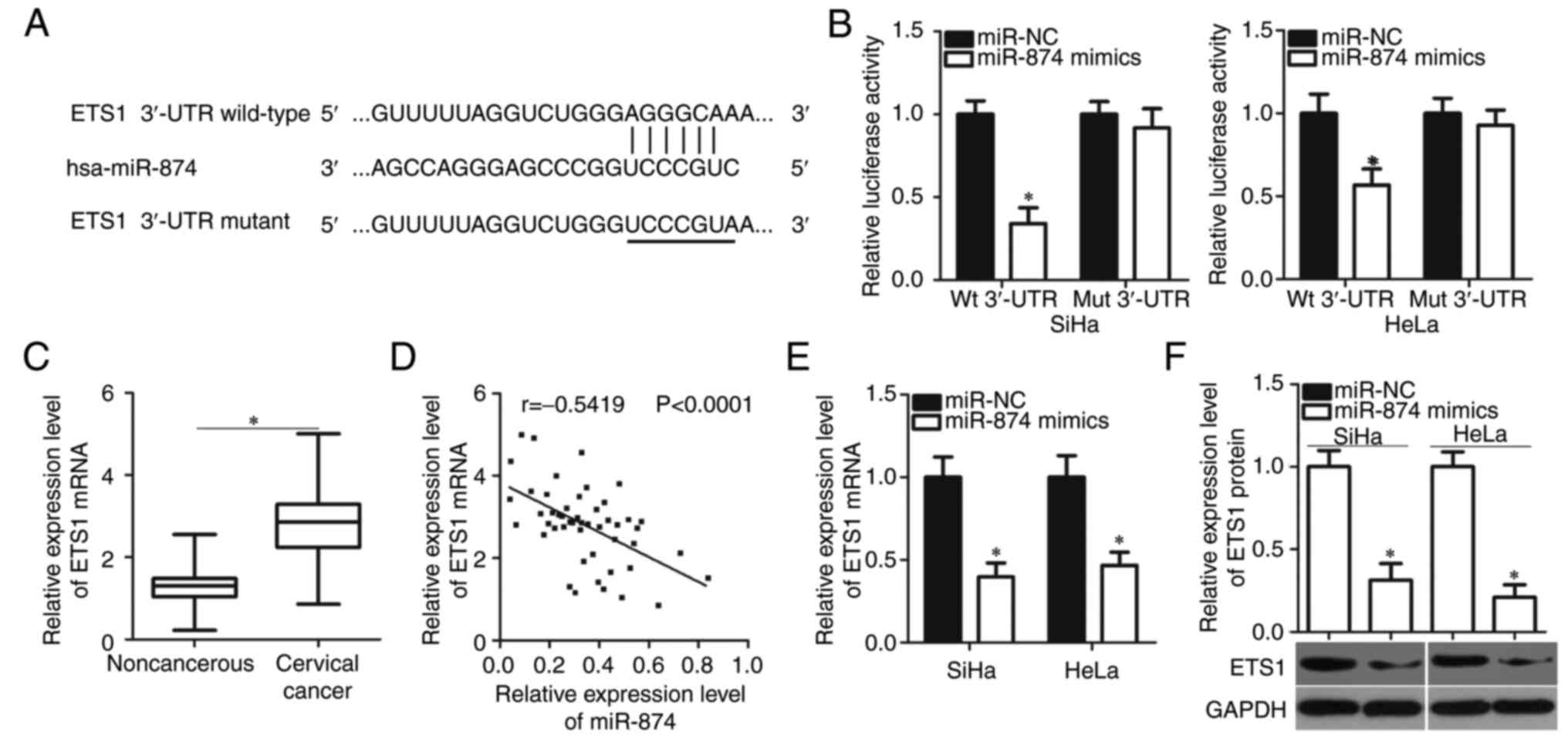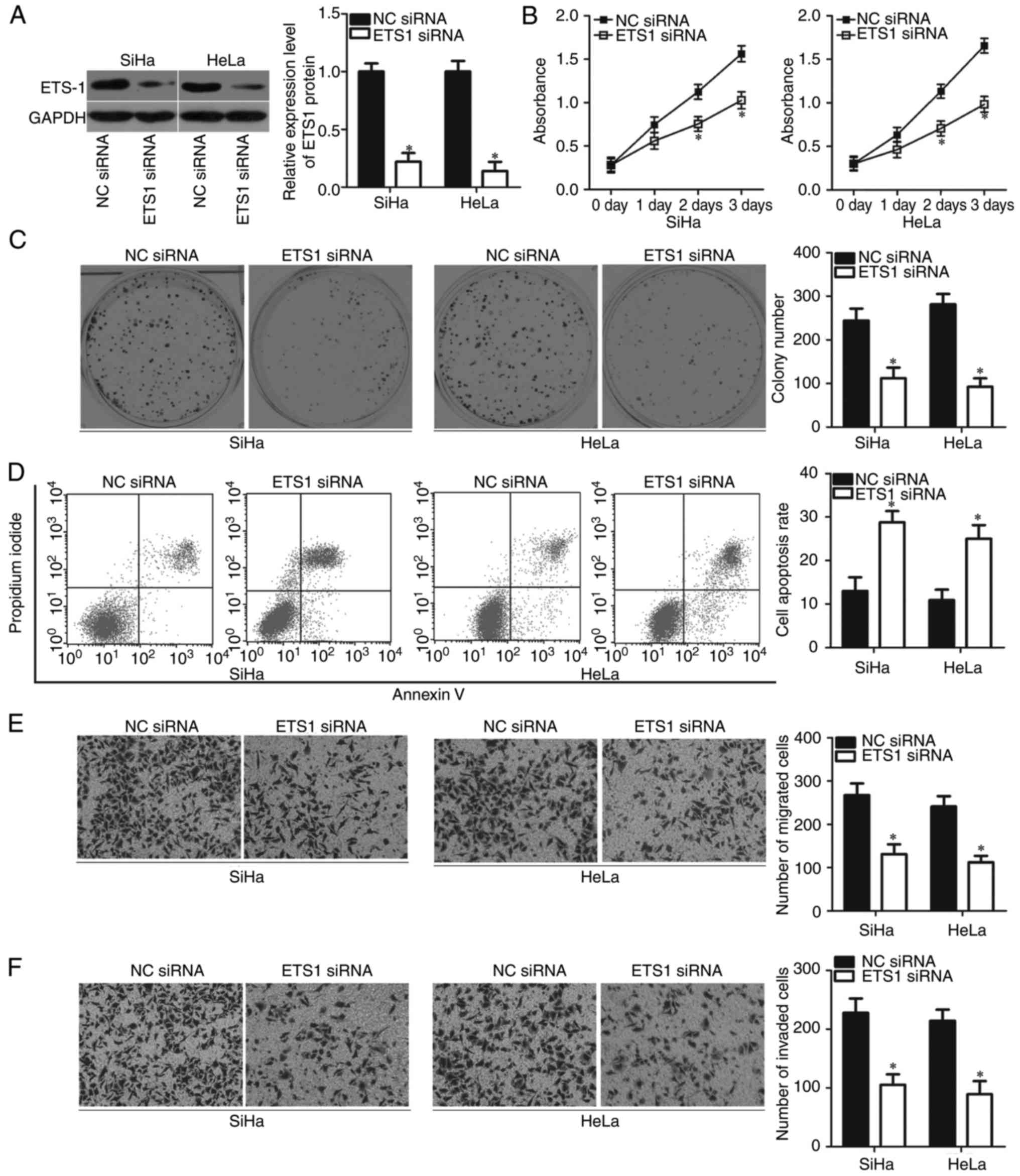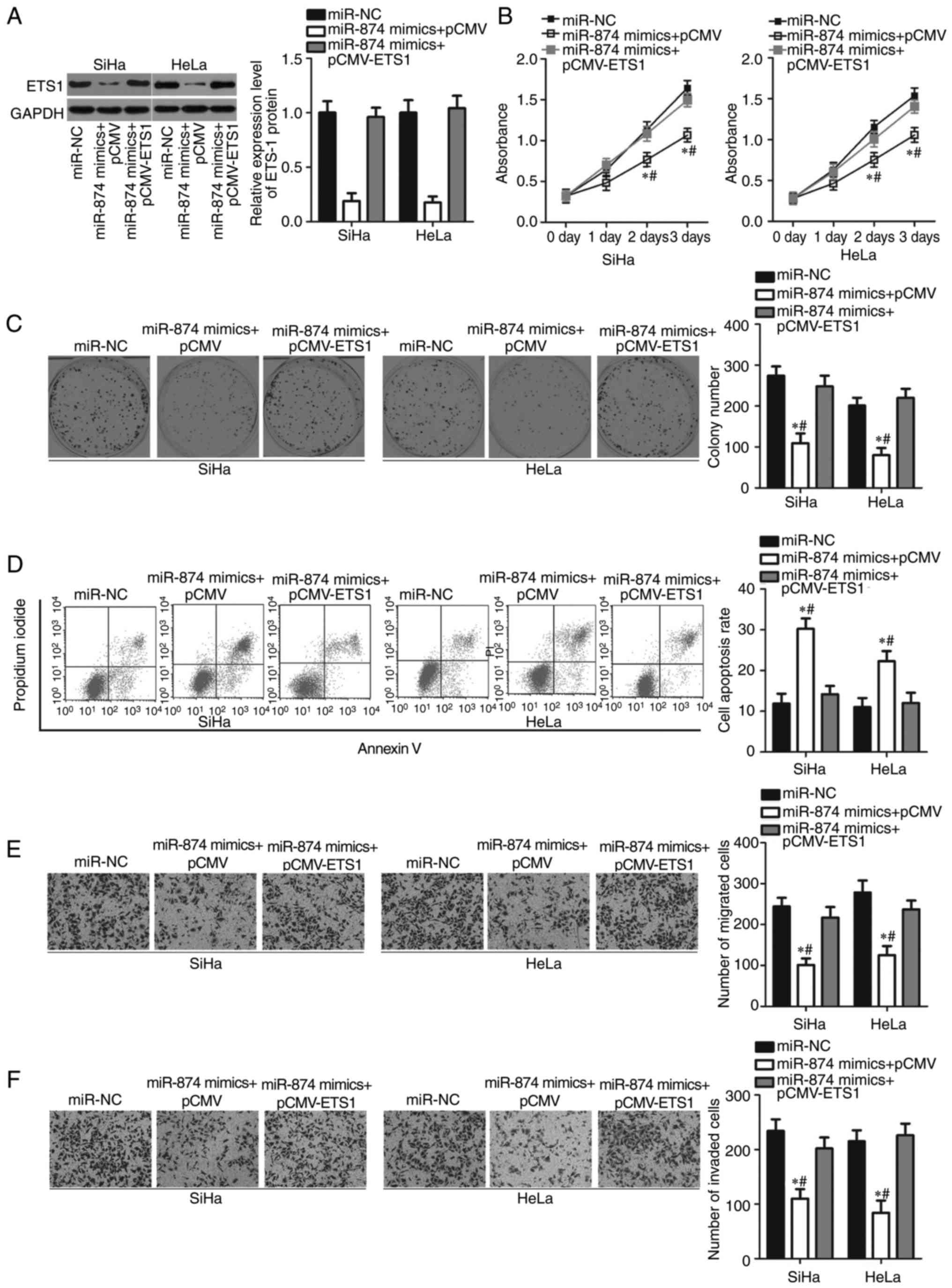MicroRNA‑874 is downregulated in cervical cancer and inhibits cancer progression by directly targeting ETS1
Retraction in: /10.3892/or.2022.8380
- Authors:
- Published online on: August 2, 2018 https://doi.org/10.3892/or.2018.6624
- Pages: 2389-2398
Abstract
Introduction
Cervical cancer is the third most common type of gynaecological cancer and the fourth leading cause of cancer-related mortality worldwide (1). A total of 530,000 new cases and 275,000 mortalities were estimated to be caused by cervical cancer annually worldwide (2). Currently, the mainstay therapy for patients with cervical cancer includes surgical resection, radiotherapy, chemotherapy and other comprehensive treatments (3). Despite substantial advances in diagnostic technologies and therapeutic methods, the therapeutic outcomes of patients with cervical cancer remain unsatisfactory, particularly for those diagnosed with an advanced stage of disease (4). Distant metastasis, lymph node recurrence and cancer recurrence are primarily responsible for the unfavourable prognosis of patients with cervical cancer (5). Persistent human papillomavirus (HPV) infection has been identified as a primary cause of cervical cancer (6). However, the detailed mechanisms of the pathogenesis of cervical cancer remain largely elusive. Therefore, further investigation into the mechanisms underlying the tumour onset and aggressiveness of cervical cancer is required in order to identify novel therapeutic targets that may improve the prognosis of patients with this disease.
MicroRNAs (miRNAs) are a large group of endogenous, single-stranded, non-coding RNA molecules comprising 18–25 nucleotides (7). miRNAs regulate genes expression by directly interacting with the complementary sites from the 3′-untranslated regions (3′-UTRs) of their target genes, causing mRNA degradation and/or translation inhibition (8). One miRNA can modulate numerous target genes; therefore, miRNAs naturally serve as key regulators of various physiological and pathological behaviours, including cell proliferation, cycle, apoptosis, differentiation, metabolism and metastasis (9). Recent studies have revealed that miRNAs are deregulated in the majority of human malignancies and that their deregulation is involved in tumourigenesis and tumour development (10,11). In cervical cancer, various miRNAs are aberrantly expressed, including miR-379 (12), miR-383 (13), miR-466 (14) and miR-1297 (15). Furthermore, miRNAs may serve tumour-suppressing or oncogenic roles in cervical cancer, depending on the detailed roles of their target genes (16,17). Therefore, miRNAs may be identified as promising therapeutic targets for treating patients with cervical cancer.
Recent studies have reported that miR-874 is frequently dysregulated in multiple types of human cancer, and that it acts as a key player in tumourigenesis and tumour development (18–21). However, the expression pattern, impacts and underlying mechanisms of miR-874 in cervical cancer have not been elucidated. Therefore, the present study measured miR-874 expression, analysed the biological roles of miR-874 and investigated its molecular mechanisms in cervical cancer cells.
Materials and methods
Tissue samples
In total, 49 pairs of cervical cancer tissues and adjacent non-cancerous tissues were collected from patients (age range, 46–72 years; mean age, 63 years) who underwent surgical resection at Huzhou Central Hospital (Zhejiang, China) between May 2014 and March 2016. None of the patients had been treated with chemotherapy or radiotherapy prior to surgery. All fresh tissues were quickly frozen in liquid nitrogen and stored at −80°C. The present study was approved by the Ethics Committee of Huzhou Central Hospital, and written informed consent was provided by all participants.
Cell culture
A total of four cervical cancer cell lines (SiHa, HeLa, C-33A and CaSki) and a normal human cervix epithelial cell line (Ect1/E6E7) were purchased from American Type Culture Collection (Manassas, VA, USA). All cell lines were cultured in Dulbecco's modified Eagle's medium (DMEM) containing 10% v/v fetal bovine serum (FBS), 1% v/v penicillin/streptomycin mixture (all from Gibco; Thermo Fisher Scientific, Inc., Waltham, MA, USA), and maintained at 37°C in an incubator with 5% CO2 and 95% air.
Transfection assay
miR-874 mimics, negative control miRNA mimics (miR-NC), small interfering RNA (siRNA) targeting the expression of ETS1 (ETS1 siRNA) and negative control siRNA (NC siRNA) were obtained from Shanghai GenePharma Co., Ltd. (Shanghai, China). The sequences used were as follows: miR-874 mimic, 5′-CUGCCCUGGCCCGAGGGACCGA-3′; miR-NC, 5′-UUCUCCGAACGUGUCACGUTT-3′; ETS1 siRNA, 5′-ACUUGCUACCAUCCCGUACTT-3′; and NC siRNA, 5′-UUCUCCGAACGUGUCACGUTT-3′. In order to restore ETS1 expression, the ETS1 overexpression plasmid pCMV-ETS1 and empty plasmid pCMV, which were chemically synthesised by the Chinese Academy of Sciences (Shanghai, China), were applied. For cell transfection, cells were inoculated into 6-well plates one day prior to transfection. miRNA mimics (100 pmol), siRNA (100 pmol) or plasmids (4 µg) were transfected into cells using Lipofectamine 2000 reagent (Invitrogen; Thermo Fisher Scientific, Inc., Waltham, MA, USA), according to the manufacturer's protocol. At 8 h post-transfection, the cell culture medium was discarded, and fresh DMEM containing 10% v/v FBS was added into each well.
Reverse transcription-quantitative polymerase chain reaction (RT-qPCR)
Total RNA from tissue specimens and culture cells was isolated using the TRIzol reagent (Invitrogen; Thermo Fisher Scientific, Inc., Waltham, MA, USA), according to the manufacturer's protocol. To quantify miR-874 expression, reverse transcription was performed using a TaqMan miRNA Reverse Transcription kit (Applied Biosystems; Thermo Fisher Scientific, Inc.), according to the manufacturer's protocols. The temperature protocol for reverse transcription was as follows: 16°C for 30 min, 42°C for 30 min and 85°C for 5 min. Next, a TaqMan miRNA PCR kit (Applied Biosystems; Thermo Fisher Scientific, Inc.) was adopted for qPCR, with U6 small nuclear RNA as an internal reference. The thermocycling conditions for qPCR were as follows: 50°C for 2 min, 95°C for 10 min; 40 cycles of denaturation at 95°C for 15 sec; and annealing/extension at 60°C for 60 sec. To determine the level of ETS1 mRNA, complementary DNA (cDNA) was produced from total RNA using a PrimeScript RT reagent kit and this DNA was then subjected to qPCR using a SYBR Premix Ex Taq™ (both Takara Biotechnology Co., Ltd., Dalian, China). The temperature protocol for reverse transcription was as follows: 37°C for 15 min and 85°C for 5 sec. qPCR was performed using the following thermocycling conditions: 5 min at 95°C, followed by 40 cycles of 95°C for 30 sec and 65°C for 45 sec. The primers were designed as follows: miR-874 forward, 5′-TGCGGCTGCCCTGGCCCGAGGGAC-3′ and reverse, 5′-CCAGTGCAGGGTCCGAGGT-3′; U6 forward, 5′-GCTTCGGCAGCACATATACTAAAAT-3′ and reverse, 5′-CGCTTCACGAATTTGCGTGTCAT-3′; ETS1 forward, 5′-CCACCACTACTACCGAAA-3′ and reverse, 5′-AACACTTCTGCTTGATGGC-3′; and GAPDH forward, 5′-CGGAGTCAACGGATTTGGTCGTAT-3′ and reverse, 5′-AGCCTTCTCCATGGTGGTGAAGAC-3′. GAPDH served as an internal control for ETS1 mRNA expression. The relative expression of miR-874 and ETS1 was analysed using the 2−ΔΔCq method (22).
Cell Counting kit-8 (CCK-8) assay
CCK-8 assay was performed to determine cell proliferative ability. In brief, transfected cells were seeded into 96-well plates at a density of 3×103 cells per well and incubated at 37°C under 5% CO2 for 0, 1, 2 or 3 days. At indicated time points, CCK-8 assay was initiated by adding 10 µl CCK-8 solution (Dojindo Molecular Technologies, Inc., Kumamoto, Japan) into each well. Following incubation at 37°C for 2 h, the absorbance value of each well was detected at a wavelength of 450 nm using a microplate reader (Bio-Rad Laboratories, Inc., Hercules, CA, USA).
Colony formation assay
At 24 h after transfection, cells were harvested and prepared into a single-cell suspension. Transfected cells were plated into 6-well plates at a density of 1,000 cells/well and were then incubated at 37°C in an incubator under 5% CO2 and 95% air for 14 days. At day 15, the cells were fixed with 95% methanol for 20 min at room temperature and stained with methyl violet (Beyotime Institute of Biotechnology, Shanghai, China) at room temperature for 20 min. The number of cell colonies (>50 cells/colony) was counted under an inverted microscope (×200 magnification; IX83; Olympus Corporation, Tokyo, Japan).
Flow cytometric assay
Transfected cells were incubated at 37°C in an incubator under 5% CO2 and 95% air for 48 h. Subsequently, the transfected cells were collected, washed with PBS and then subjected to cell apoptosis detection using an Annexin V fluorescein isothiocyanate (FITC) apoptosis detection kit (BioLegend, Inc., San Diego, CA, USA). In brief, transfected cells were resuspended with 100 µl binding buffer. Next, the transfected cells were stained with 5 µl Annexin V-FITC and 5 µl propidium iodide (PI) at room temperature. Following incubation for 20 min in the dark, the cell apoptosis rate was detected using a flow cytometer (FACScan; BD Biosciences, Franklin Lakes, NJ, USA), and analyzed using CellQuest software version 3.3 (BD Biosciences, Franklin Lakes, NJ, USA).
Transwell migration and invasion assays
Cell migration and invasion abilities were determined using Transwell chambers (Corning Incorporated, Corning, NY, USA) coated without or with Matrigel (BD Biosciences), respectively. Transfected cells were collected at 48 h post-transfection and were resuspended with FBS-free DMEM. The upper Transwell chambers were filled with 1×105 cells in FBS-free DMEM, and the lower chambers were filled with 500 µl DMEM containing 10% FBS. The chambers were incubated at 37°C in an atmosphere of 5% CO2 and 95% air for 24 h. The cells were fixed with 95% methanol at room temperature for 15 min, stained with 0.5% crystal violet at room temperature for 15 min and washed with PBS. The number of migrated and invaded cells in five randomly selected visual fields/chambers was counted under an inverted microscope at ×200 magnification.
Bioinformatics analysis and luciferase reporter assay
TargetScan7.1 (http://www.targetscan.org/) and microRNA.org (http://www.microrna.org/microrna/home.do) were applied to predict the putative targets of miR-874. ETS1 was predicted as a major potential target of miR-874. The wild-type (Wt) and mutant (Mut) 3′-UTR of ETS1 was produced by Shanghai GenePharma Co., Ltd. and inserted into the pGL3 luciferase vector (Promega Corporation, Madison, WI, USA) to generate pGL3-ETS1-3′-UTR Wt and pGL3-ETS1-3′-UTR Mut, respectively. Cells were inoculated into 24-well plates at a density of 1.0×105 cells each well. Following overnight incubation, miR-874 mimics or miR-NC, in combination with pGL3-ETS1-3′-UTR Wt or pGL3-ETS1-3′-UTR Mut, were transfected into cells using Lipofectamine 2000 reagent. Luciferase activities were detected at 48 h post-transfection using a Dual Luciferase Reporter assay kit (Promega Corporation), according to the manufacturer's protocol. Firefly luciferase activity was normalized to Renilla luciferase activity.
Western blot analysis
Total protein was extracted from tissue specimens or culture cells using radioimmunoprecipitation assay buffer, and the concentration of total protein was quantified using a bicinchoninic acid assay kit (both Beyotime Institute of Biotechnology, Inc., Shanghai, China). Subsequently, 10% SDS-PAGE was utilised to separate equal amounts of proteins (20 µg); the separated proteins were transferred onto polyvinylidene difluoride membranes (EMD Millipore, Billerica, MA, USA). Subsequently, membranes were blocked with 5% skimmed milk that was dissolved in Tris-buffered saline containing 0.1% Tween-20 (TBST) for 1 h at room temperature. The membranes were incubated with monoclonal anti-mouse ETS1 antibody (1:1,000 dilution; cat. no. ab96478; Abcam, Cambridge, UK) and monoclonal anti-rabbit GAPDH (1:1,000 dilution; cat. no. ab9484; Abcam) primary antibodies overnight at 4°C. Following washing three times with TBST, the membranes were incubated with corresponding horseradish peroxidase-conjugated secondary antibodies (1:5,000 dilution; cat. no. ab6789; Abcam) at room temperature for 2 h. The protein signals were visualised using an enhanced chemiluminescence plus reagent (GE Healthcare, Chicago, IL, USA). Protein expression was quantified using Quantity One software version 4.62 (Bio-Rad Laboratories, Inc., Hercules, CA, USA).
Statistical analysis
Statistical analysis was performed using SPSS software (version 18.0; SPSS, Inc., Chicago, IL, USA). Data are expressed as the mean ± standard deviation from ≥3 independent experiments and analysed using Student's t-test or one-way analysis of variance (ANOVA). Student-Newman-Keuls test was applied for post hoc analysis following ANOVA. The association between miR-874 and the clinicopathological features of patients with cervical cancer was analysed using χ2 test. Spearman's correlation analysis was performed to evaluate the correlation between miR-874 and ETS1 mRNA in cervical cancer tissues. P<0.05 were considered to indicate a statistically significant difference.
Results
miR-874 is downregulated in cervical cancer tissues and cell lines
To clarify the expression pattern of miR-874 in cervical cancer, miR-874 expression was initially detected in 49 pairs of cervical cancer tissues and adjacent non-cancerous tissues. The results of RT-qPCR analysis demonstrated that miR-874 expression was downregulated in cervical cancer tissues compared with that in adjacent non-cancerous tissues (P<0.05; Fig. 1A). To determine the clinical significance of miR-874 in cervical cancer, the association between miR-874 and the clinicopathological features of patients with cervical cancer was determined. All patients were divided into either low- or high-expression groups based on the median expression of miR-874. The results demonstrated that reduced miR-874 levels were correlated with the FIGO stage (P=0.007) and lymph node metastasis (P=0.032). However, no significant correlation was observed with other clinicopathological factors, including age, tumour size or family history of cancer (all P>0.05; Table I). The expression level of miR-874 was also determined in four cervical cancer cell lines (SiHa, HeLa, C-33A and CaSki) and a normal human cervix epithelial cell line (Ect1/E6E7). miR-874 expression was downregulated in all the tested cervical cancer cell lines, compared with that in Ect1/E6E7 cells (P<0.05; Fig. 1B). These results suggested that miR-874 is associated with cervical cancer progression.
Table I.Association between miR-874 and clinicopathological features of patients with cervical cancer. |
miR-874 inhibits the proliferation and promotes the apoptosis of cervical cancer cells
To illustrate the biological roles of miR-874 in cervical cancer, the SiHa and HeLa cells were used, which exhibited relatively lower miR-874 expression compared with the two other cervical cancer cell lines in subsequent functional assays. SiHa and HeLa cells were transfected with miR-874 mimics or miR-NC. The results of RT-qPCR analysis confirmed that miR-874 was markedly overexpressed in SiHa and HeLa cells following transfection with miR-874 mimics (P<0.05; Fig. 2A). CCK-8 assay was performed to detect the proliferation of SiHa and HeLa cells that were transfected with miR-874 mimics or miR-NC. Ectopic miR-874 expression significantly decreased the proliferative abilities of SiHa and HeLa cells (P<0.05; Fig. 2B). To confirm this observation, a colony formation assay was used to evaluate the effect of miR-874 overexpression on colony formation ability in cervical cancer. Similarly, miR-874 upregulation significantly reduced the number and size of surviving colonies compared with the miR-NC groups (Fig. 2C; P<0.05). Flow cytometric assay was employed to examine the biological functions of miR-874 in cervical cancer cell apoptosis. The results revealed that resumption of miR-874 expression increased the apoptotic rate of SiHa and HeLa cells (Fig. 2D; P<0.05). Taken together, these results suggested that miR-874 inhibits cell proliferation and promotes cell apoptosis in cervical cancer.
miR-874 restricts cell migration and invasion in cervical cancer
Considering the association between miR-874 and lymph node metastasis, Transwell migration and invasion assays were utilised to investigate the effect of miR-874 overexpression on cervical cancer cell metastasis. SiHa and HeLa cells transfected with miR-874 mimics exhibited significantly lower migration (P<0.05; Fig. 3A) and invasion (P<0.05; Fig. 3B) abilities, compared with those transfected with miR-NC. These results suggested that miR-874 serves a tumour-suppressive role in cervical cancer metastasis.
miR-874 directly targets ETS1 in cervical cancer cells
The biological roles of miRNA depend on its specific target. Therefore, bioinformatic analysis was performed to predict the putative target genes of miR-874. According to TargetScan7.1 and microRNA.org, ETS1 was a predicted target gene of miR-874 (Fig. 4A). Luciferase reporter assay was conducted to investigate whether miR-874 directly targets the 3′-UTR of ETS1 in cervical cancer cells. miR-874 overexpression significantly suppressed the luciferase activities of the plasmid carrying the Wt binding site in SiHa and HeLa cells (P<0.05). However, the upregulation of miR-874 did not serve an inhibitory role in the luciferase activities of the plasmid harbouring the Mut binding site (Fig. 4B).
To further evaluate the association between miR-874 and ETS1 in cervical cancer, ETS1 expression was detected in 49 pairs of cervical cancer tissues and adjacent non-cancerous tissues through RT-qPCR. Results revealed that the levels of ETS1 mRNA were significantly higher in the cervical cancer tissues than in the adjacent non-cancerous tissues (P<0.05; Fig. 4C). The ETS1 mRNA levels were also identified to be inversely correlated with miR-874 expression in cervical cancer tissues (r=−0.5419; P<0.0001; Fig. 4D). The effects of miR-874 overexpression on ETS1 mRNA and protein levels in SiHa and HeLa cells were illustrated by RT-qPCR and western blot analysis, respectively. Restoration of miR-874 expression decreased ETS1 expression in SiHa and HeLa cells at mRNA (P<0.05; Fig. 4E) and protein (P<0.05; Fig. 4F) levels. Taken together, these results indicated that ETS1 is a direct target gene of miR-874 in cervical cancer.
Inhibition of ETS1 simulates the tumour-suppressive effects of miR-874 in cervical cancer cells
Considering that ETS1 is a direct target gene of miR-874 in cervical cancer, we hypothesised that inhibiting ETS1 can mimic the biological functions of miR-874 in cervical cancer cells. SiHa and HeLa cells were transfected with ETS1 siRNA to knock down endogenous ETS1 expression. Following transfection, western blot analysis revealed that ETS1 protein expression was silenced effectively in the SiHa and HeLa cells transfected with ETS1 siRNA (P<0.05; Fig. 5A). As expected, inhibition of ETS1 significantly reduced the proliferative (P<0.05; Fig. 5B) and colony-forming abilities (P<0.05; Fig. 5C) of SiHa and HeLa cells. ETS1-knockdown also promoted the apoptosis (P<0.05; Fig. 5D) and prohibited the metastasis (P<0.05; Fig. 5E and F) of SiHa and HeLa cells. These results further demonstrated that ETS1 is a direct target gene of miR-874 in cervical cancer cells.
Upregulation of ETS1 reverses the biological function of miR-874 overexpression in cervical cancer cells
To investigate whether ETS1 is a functional mediator of miR-874, rescue experiments were performed by transfecting pCMV-ETS1 or pCMV into miR-874-overexpressing SiHa and HeLa cells. Following transfection, ETS1 protein levels were detected using western blot analysis. The decrease in ETS1 protein level induced by miR-874 overexpression was significantly restored in the SiHa and HeLa cells following co-transfection with pCMV-ETS1 (P<0.05; Fig. 6A). Furthermore, recovered ETS1 expression counteracted the effects of miR-874 overexpression on the proliferation (P<0.05; Fig. 6B), colony formation (P<0.05; Fig. 6C), apoptosis (P<0.05; Fig. 6D), migration (P<0.05; Fig. 6E) and invasion (P<0.05; Fig. 6F) of SiHa and HeLa cells. These findings clearly demonstrated that miR-874 may serve as a tumour suppressor in cervical cancer progression, at least partly, by suppressing ETS1 expression.
Discussion
An increasing number of studies have reported that miRNAs are differentially expressed in cervical cancer and serve critical roles in cervical oncogenesis and progression (23–25). Therefore, identifying the aberrantly expressed miRNAs implicated in the formation and progression of cervical cancer may provide key clues for the development of effective therapeutic targets in treating patients with this malignancy. In our current study, miR-874 expression was significantly downregulated in cervical cancer tissues and cell lines. Decreased miR-874 expression was correlated with FIGO stage and lymph node metastasis. In addition, resumption of miR-874 expression suppressed the proliferation, migration and invasion, but increased the apoptosis of cervical cancer cells. Further investigation demonstrated that ETS1 is a novel target of miR-874 in cervical cancer. Furthermore, ETS1 expression was upregulated in cervical cancer tissues, and the upregulation of ETS1 was inversely correlated with miR-874 expression. Furthermore, ETS1-knockdown simulated the tumour suppressive effects of miR-874 in cervical cancer cells. Notably, reintroduction of ETS1 expression counteracted the inhibitory effects of miR-874 overexpression in cervical cancer cells. These findings suggested that miR-874 may be a valuable therapeutic target for treating patients with cervical cancer.
miR-874 is dysregulated in diverse types of human malignancy. For example, miR-874 is downregulated in colorectal cancer, and the downregulation of miR-874 is associated with TNM stage and lymph node metastasis (18). In osteosarcoma, miR-874 expression is downregulated in tumour tissues and cell lines. Low miR-874 expression is strongly correlated with TNM stage, tumour size and lymph node metastasis in patients with osteosarcoma (19). In hepatocellular carcinoma, decreased miR-874 expression in tumour tissues is significantly associated with tumour size, vascular invasion, TNM stage, tumour differentiation and inferior patient outcomes (20). In gastric cancer, miR-874 expression is reduced in clinical samples and few cell lines. The downregulation of miR-874 expression is correlated with certain characteristic features of patients with gastric cancer that indicate an unfavourable prognosis (21). These findings demonstrated that miR-874 is frequently mildly expressed in these types of human cancer and suggested that this miRNA has a strong diagnostic and prognostic value.
Dysregulation of miR-874 participates in the occurrence and development of multiple types of human cancer. For instance, miR-874 overexpression restricts colorectal cancer cell proliferation, inhibits colony formation, induces apoptosis and improves the chemosensitivity to 5-FU by directly targeting XIAP and STAT3 and inhibiting the Hippo signalling pathway (18,26,27). Dong et al demonstrated that miR-874 targets E2F3 to impede proliferation and motility, and to promote the apoptosis of osteosarcoma cells (19). Multiple studies have reported that induced expression of miR-874 suppresses the growth, metastasis and epithelial-mesenchymal transition, but promotes the apoptosis in vitro and reduces the tumourigenicity in vivo of hepatocellular carcinoma cells by inhibiting DOR, SOX12 and PIN1 expression (20,28,29). Studies by Jiang et al (21) and Zhang et al (30) revealed that miR-874 re-expression represses the angiogenesis, growth and motility in vitro, and the tumourigenicity in vivo of gastric cancer cells via the blockade of STAT3 and AQP3. These findings suggested that miR-874 may hold the potential to be developed as a therapeutic target in treating patients with these specific human malignancy types.
ETS1, a member of the ETS family of transcription factors, is validated as a direct target gene of miR-874 in cervical cancer. It directly binds to specific DNA sequences containing a GGAA/T core motif and serves crucial roles in carcinogenesis and cancer progression. ETS1 is reportedly overexpressed in multiple types of human malignant tumour, including ovarian cancer (31), colorectal cancer (32), prostate cancer (33) and gastric cancer (34). ETS1 is also upregulated in cervical cancer, and its upregulation is significantly correlated with tumour differentiation and lymph node metastasis (35). Patients with cervical cancer exhibiting high ETS1 levels exhibit a poorer prognosis than those with low ETS1 levels (35,36). The deregulated ETS1 is implicated in the oncogenesis and development of multiple types of human cancer by regulating several pathological behaviours (37–39). Taken together, these findings indicated that targeting ETS1 through miRNA-based targeted therapy has promising therapeutic applications in treating patients with cervical cancer.
In summary, to the best of our knowledge, the present study was the first to reveal that miR-874 inhibits the progression of cervical cancer by directly targeting ETS1. These findings highlighted the importance of the miR-874/ETS1 pathway in the treatment of cervical cancer in the future.
Acknowledgements
Not applicable.
Funding
Not applicable.
Availability of data and materials
The datasets used and/or analyzed during the present study are available from the corresponding author on reasonable request.
Authors' contributions
YJ and HL designed this research. HL, YunfeiP, YuefenP, JS, QQ and LZ performed functional experiments. WH and QW analyzed the data of this study. All authors have read and approved the final draft.
Ethics approval and consent to participate
The present study was approved by the Ethics Committee of Huzhou Central Hospital (Huzhou, China), and was performed in accordance with the Declaration of Helsinki and the guidelines of the Ethics Committee of Huzhou Central Hospital. Written informed consent was obtained from all patients for the use of their clinical tissues.
Patient consent for publication
Not applicable.
Competing interests
The authors declare that they have no competing interests.
References
|
Torre LA, Bray F, Siegel RL, Ferlay J, Lortet-Tieulent J and Jemal A: Global cancer statistics, 2012. CA Cancer J Clin. 65:87–108. 2015. View Article : Google Scholar : PubMed/NCBI | |
|
Arbyn M, Castellsagué X, de Sanjosé S, Bruni L, Saraiya M, Bray F and Ferlay J: Worldwide burden of cervical cancer in 2008. Ann Oncol. 22:2675–2686. 2011. View Article : Google Scholar : PubMed/NCBI | |
|
Marth C, Landoni F, Mahner S, McCormack M, Gonzalez-Martin A and Colombo N: Cervical cancer: ESMO clinical practice guidelines for diagnosis, treatment and follow-up. Ann Oncol. 28:iv72–iv83. 2017. View Article : Google Scholar : PubMed/NCBI | |
|
Seoud M, Tjalma WA and Ronsse V: Cervical adenocarcinoma: Moving towards better prevention. Vaccine. 29:9148–9158. 2011. View Article : Google Scholar : PubMed/NCBI | |
|
Kogo R, How C, Chaudary N, Bruce J, Shi W, Hill RP, Zahedi P, Yip KW and Liu FF: The microRNA-218~Survivin axis regulates migration, invasion, and lymph node metastasis in cervical cancer. Oncotarget. 6:1090–1100. 2015. View Article : Google Scholar : PubMed/NCBI | |
|
Matsukura T and Sugase M: Pitfalls in the epidemiologic classification of human papillomavirus types associated with cervical cancer using polymerase chain reaction: Driver and passenger. Int J Gynecol Cancer. 18:1042–1050. 2008. View Article : Google Scholar : PubMed/NCBI | |
|
He L and Hannon GJ: MicroRNAs: Small RNAs with a big role in gene regulation. Nat Rev Genet. 5:522–531. 2004. View Article : Google Scholar : PubMed/NCBI | |
|
Bartel DP: MicroRNAs: Target recognition and regulatory functions. Cell. 136:215–233. 2009. View Article : Google Scholar : PubMed/NCBI | |
|
Calin GA and Croce CM: MicroRNA signatures in human cancers. Nat Rev Cancer. 6:857–866. 2006. View Article : Google Scholar : PubMed/NCBI | |
|
Macfarlane LA and Murphy PR: MicroRNA: Biogenesis, function and role in cancer. Curr Genomics. 11:537–561. 2010. View Article : Google Scholar : PubMed/NCBI | |
|
Kent OA and Mendell JT: A small piece in the cancer puzzle: MicroRNAs as tumor suppressors and oncogenes. Oncogene. 25:6188–6196. 2006. View Article : Google Scholar : PubMed/NCBI | |
|
Shi X, Yuan N, Zhang S, Yuan F and Wang X: MicroRNA-379 suppresses cervical cancer cell proliferation and invasion by directly targeting V-crk avian sarcoma virus CT10 oncogene homolog-like. Oncol Res. Jan 2–2018.(Epub ahead of print). doi: 10.3727/096504017X15140534417184. View Article : Google Scholar | |
|
Teng P, Jiao Y, Hao M and Tang X: microRNA-383 suppresses the PI3K-AKT-MTOR signaling pathway to inhibit development of cervical cancer via down-regulating PARP2. J Cell Biochem. 119:5243–5252. 2018. View Article : Google Scholar : PubMed/NCBI | |
|
Zhou LL, Shen Y, Gong JM, Sun P and Sheng JH: MicroRNA-466 with tumor markers for cervical cancer screening. Oncotarget. 8:70821–70827. 2017.PubMed/NCBI | |
|
Wang Z, He S, Guo P, Guo X and Zheng J: MicroRNA-1297 inhibits metastasis and epithelial-mesenchymal transition by targeting AEG-1 in cervical cancer. Oncol Rep. 38:3121–3129. 2017. View Article : Google Scholar : PubMed/NCBI | |
|
Mei J, Wang DH, Wang LL, Chen Q, Pan LL and Xia L: MicroRNA-200c suppressed cervical cancer cell metastasis and growth via targeting MAP4K4. Eur Rev Med Pharmacol Sci. 22:623–631. 2018.PubMed/NCBI | |
|
Zhang Z, Wang J, Wang X, Song W, Shi Y and Zhang L: MicroRNA-21 promotes proliferation, migration, and invasion of cervical cancer through targeting TIMP3. Arch Gynecol Obstet. 297:433–442. 2018. View Article : Google Scholar : PubMed/NCBI | |
|
Han J, Liu Z, Wang N and Pan W: MicroRNA-874 inhibits growth, induces apoptosis and reverses chemoresistance in colorectal cancer by targeting X-linked inhibitor of apoptosis protein. Oncol Rep. 36:542–550. 2016. View Article : Google Scholar : PubMed/NCBI | |
|
Dong D, Gong Y, Zhang D, Bao H and Gu G: miR-874 suppresses the proliferation and metastasis of osteosarcoma by targeting E2F3. Tumour Biol. 37:6447–6455. 2016. View Article : Google Scholar : PubMed/NCBI | |
|
Zhang Y, Wei Y, Li X, Liang X, Wang L, Song J, Zhang X, Zhang C, Niu J, Zhang P, et al: microRNA-874 suppresses tumor proliferation and metastasis in hepatocellular carcinoma by targeting the DOR/EGFR/ERK pathway. Cell Death Dis. 9:1302018. View Article : Google Scholar : PubMed/NCBI | |
|
Jiang B, Li Z, Zhang W, Wang H, Zhi X, Feng J, Chen Z, Zhu Y, Yang L, Xu H and Xu Z: miR-874 inhibits cell proliferation, migration and invasion through targeting aquaporin-3 in gastric cancer. J Gastroenterol. 49:1011–1025. 2014. View Article : Google Scholar : PubMed/NCBI | |
|
Livak KJ and Schmittgen TD: Analysis of relative gene expression data using real-time quantitative PCR and the 2−ΔΔCT method. Methods. 25:402–408. 2001. View Article : Google Scholar : PubMed/NCBI | |
|
Granados-López AJ, Ruiz-Carrillo JL, Servín-González LS, Martínez-Rodríguez JL, Reyes-Estrada CA, Gutiérrez-Hernández R and López JA: Use of mature miRNA strand selection in miRNAs families in cervical cancer development. Int J Mol Sci. 18:E4072017. View Article : Google Scholar : PubMed/NCBI | |
|
Li J, Liu Q, Clark LH, Qiu H, Bae-Jump VL and Zhou C: Deregulated miRNAs in human cervical cancer: Functional importance and potential clinical use. Future Oncol. 13:743–753. 2017. View Article : Google Scholar : PubMed/NCBI | |
|
Dai S, Lu Y, Long Y, Lai Y, Du P, Ding N and Yao D: Prognostic value of microRNAs in cervical carcinoma: A systematic review and meta-analysis. Oncotarget. 7:35369–35378. 2016. View Article : Google Scholar : PubMed/NCBI | |
|
Zhao B and Dong AS: MiR-874 inhibits cell growth and induces apoptosis by targeting STAT3 in human colorectal cancer cells. Eur Rev Med Pharmacol Sci. 20:269–277. 2016.PubMed/NCBI | |
|
Que K, Tong Y, Que G, Li L, Lin H, Huang S, Wang R and Tang L: Downregulation of miR-874-3p promotes chemotherapeutic resistance in colorectal cancer via inactivation of the Hippo signaling pathway. Oncol Rep. 38:3376–3386. 2017.PubMed/NCBI | |
|
Jiang T, Guan LY, Ye YS, Liu HY and Li R: MiR-874 inhibits metastasis and epithelial-mesenchymal transition in hepatocellular carcinoma by targeting SOX12. Am J Cancer Res. 7:1310–1321. 2017.PubMed/NCBI | |
|
Leong KW, Cheng CW, Wong CM, Ng IO, Kwong YL and Tse E: miR-874-3p is down-regulated in hepatocellular carcinoma and negatively regulates PIN1 expression. Oncotarget. 8:11343–11355. 2017. View Article : Google Scholar : PubMed/NCBI | |
|
Zhang X, Tang J, Zhi X, Xie K, Wang W, Li Z, Zhu Y, Yang L, Xu H and Xu Z: miR-874 functions as a tumor suppressor by inhibiting angiogenesis through STAT3/VEGF-A pathway in gastric cancer. Oncotarget. 6:1605–1617. 2015.PubMed/NCBI | |
|
Lin Z, Liu Y, Sun Y and He X: Expression of Ets-1, Ang-2 and maspin in ovarian cancer and their role in tumor angiogenesis. J Exp Clin Cancer Res. 30:312011. View Article : Google Scholar : PubMed/NCBI | |
|
Tokuhara K, Ogata Y, Nakagawa M and Shirouzu K: Ets-1 expression in vascular endothelial cells as an angiogenic and prognostic factor in colorectal carcinoma. Int Surg. 88:25–33. 2003.PubMed/NCBI | |
|
Xu S, Ge J, Zhang Z and Zhou W: MiR-129 inhibits cell proliferation and metastasis by targeting ETS1 via PI3K/AKT/mTOR pathway in prostate cancer. Biomed Pharmacother. 96:634–641. 2017. View Article : Google Scholar : PubMed/NCBI | |
|
Zheng L, Qi T, Yang D, Qi M, Li D, Xiang X, Huang K and Tong Q: microRNA-9 suppresses the proliferation, invasion and metastasis of gastric cancer cells through targeting cyclin D1 and Ets1. PLoS One. 8:e557192013. View Article : Google Scholar : PubMed/NCBI | |
|
Xu FL, Li YL, Wang ZD and Feng YJ: Expression and significance about VEGF, KDR, MMP-1, and transcription factor Ets-1 in human cervical carcinoma. Zhongguo Yi Xue Ke Xue Yuan Xue Bao. 25:396–400. 2003.(In Chinese). PubMed/NCBI | |
|
Fujimoto J, Aoki I, Toyoki H, Khatun S and Tamaya T: Clinical implications of expression of ETS-1 related to angiogenesis in uterine cervical cancers. Ann Oncol. 13:1598–1604. 2002. View Article : Google Scholar : PubMed/NCBI | |
|
Tomar S, Plotnik JP, Haley J, Scantland J, Dasari S, Sheikh Z, Emerson R, Lenz D, Hollenhorst PC and Mitra AK: ETS1 induction by the microenvironment promotes ovarian cancer metastasis through focal adhesion kinase. Cancer Lett. 414:190–204. 2018. View Article : Google Scholar : PubMed/NCBI | |
|
Wu M, Liu X, Jin W, Li Y, Li Y, Hu Q, Chu PK, Tang G and Ping Y: Targeting ETS1 with RNAi-based supramolecular nanoassemblies for multidrug-resistant breast cancer therapy. J Control Release. 253:110–121. 2017. View Article : Google Scholar : PubMed/NCBI | |
|
Zhang SY, Lu ZM, Lin YF, Chen LS, Luo XN, Song XH, Chen SH and Wu YL: miR-144-3p, a tumor suppressive microRNA targeting ETS-1 in laryngeal squamous cell carcinoma. Oncotarget. 7:11637–11650. 2016.PubMed/NCBI |



